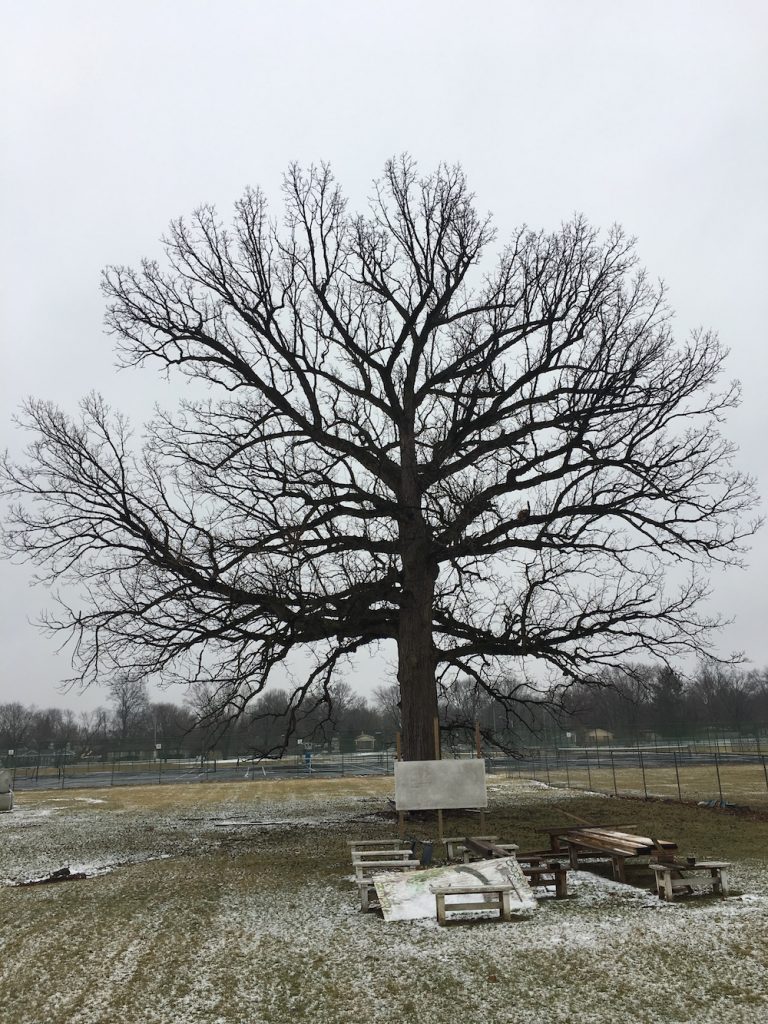Last week, a staff member at Eastwood Middle School in Indianapolis alerted IFA about an a old, majestic bur oak tree in harm’s way — due to plans for a new parking lot. “I would like the tree to be saved,” wrote school counselor Kelly Spiegel.
Kelly sent photos and we posted them on social media. Forests for Indy Project Director Jerome Delbridge went to inspect the tree. “This bur oak is 53.7” diameter, 80’ tall,” he reported. “I didn’t see any significant health or structural defects with the tree. The limbs spread nearly 100 feet wide. I would put the age of the tree at 225 to 250 years old, with the assumption it was a forest tree, pre-1900. What a treasure!”
Eastwood alumni remember this tree. They are contacting school officials to make a case for the tree. Other forest advocates are asking Schmidt & Associates (the project architect/engineers) to re-imagine the project to accommodate the tree.
IFA Board President Elizabeth Mahoney quickly issued a passionate e-mail to the superintendent of Washington Township Schools, Dr. Nikki Woodson:
“I am writing to you today to respectfully request that your School District and the Eastwood Middle School re-evaluate your decision to cut down the beautiful old oak tree for a parking lot. Indianapolis is so very low in ranking per capita of green space and trees. It is a shame and a horrible thing to destroy this beautiful part of Eastwood school’s natural history. Climate change is real. Big trees like this clean our air by removing particulates, sequesters CO2 and creates clean breathable oxygen for humans and animals alike, not to mention they are a food source and habitat for birds, squirrels bats and insects. Additionally, a tree of this size and maturity soaks up thousands and thousands of gallons of water annually and helps your school with water run off issues during our increasingly torrential rain falls, another side-effect of global warming.
This could and should be a teachable moment for your students. Just because this tree is located in an area where it’s most convenient to locate a parking lot does not mean that you should locate the parking lot there and that the tree must be cut down.
Your architectural planning committee could, in conjunction with an arborist, leave enough area around the tree to save the tree, create a beautiful landscape feature and still a have functional parking lot. So what if it eliminates a few parking spots!
Additionally, teaching students to always take the easiest, cheapest and least creative path is not ideal. There are always multiple ways to solve problems. Teaching exploration, creative process solutions and working a little harder to solve a problem is always the better path. I’m sure you would agree.
Please do not cut down this tree for a parking lot. It teaches your students that nature, our environment, is unimportant and that it is simply something to be dealt with and controlled as opposed to something important for our minds, bodies and spirits. We humans ARE nature. We are all part of the cycle and the impact we have on the planet today will be felt for generations to come.”
FOX 59 News came out to cover the tree’s fate. “I think there is always an alternative where we can co-habitat with the nature around us,” said Jerome Delbridge, an ISA certified arborist.
As of this writing, Eastwood school leaders say they are verifying “the type, age, and health of the tree. In addition, site and civil conditions are being evaluated to determine possible alternative options that might allow construction to take place around the oak tree.”
Another point to make is that the Natural Resources section of the City of Indianapolis’ new THRIVE INDY plan calls for these actions:
Promoting tree planting and green infrastructure installation to help reduce the urban heat island effect, absorb water to mitigate flooding and filter some water pollutants
Fostering growth of urban forests to improve air quality and absorb carbon
Enhancing existing and creating more green spaces to provide recreational opportunities, health benefits and wildlife habitat
What an opportunity to practice what we preach.
Jerome Delbridge added: “This space has been used for outdoor education in the past, celebrating this tree. We believe the tree should continue to be revered and preserved as it is likely the oldest living organism on campus. Much space on campus is given for sports fields. I believe ample space should also be dedicated to ecology and nature.”
Give the school superintendent an encouraging call at (317) 205-3332 and urge the right choice!

